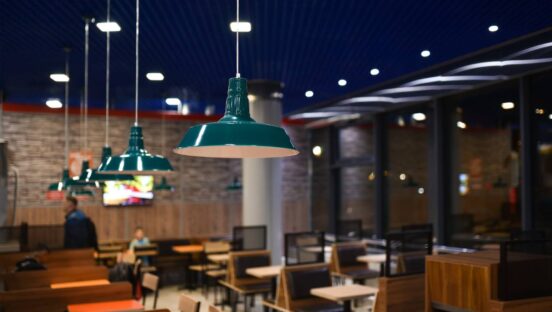You can’t bank on many things in the restaurant industry but you can surely count on this: Real estate is going to be a pain. Past just landing on the right market (here’s some help picking), the challenges are endless and evergreen. Buxton, a leading customer analytics and predictive analytics platform, released its 2019 Retail and Restaurant Real Estate Outlook to help operators tackle some of the top issues at hand. Check the full download here.
Starting with the 30,000-foot view
The U.S. retail and restaurant real estate market has experienced robust activity in the years following the Great Recession, Buxton says. However, the activity has tapered off lately. While metrics are still positive, there’s a pervading sense in the industry that the current volumes won’t last. “Complicating the projections is the fact that the industry is seeing a sharp split between demand for class A properties and all other property types,” Buxton says.
One of the key health indicators remains vacancy rates. Currently, the overall national retail vacancy rate is low. Statista data shows that vacancy rates are expected to rise slightly to 12.1 percent at the beginning of 2019, fall to 11.9 percent in the second quarter, and then rise to 12.3 percent by year’s end.
But how does this change across property types?
In CBRE’s Q2 2018 update, it said vacancy rates are increasing in some but not all segments. The lifestyle and mall segment was hit hard (no surprise) by store closures and has increased in availability since the last quarter of 2016. This is a widely publicized trend and more critical beyond the A malls of America. Those less-prime outlets are being plagued by declining foot traffic and changing consumer behavior to a much larger extent. It’s why brands like The Cheesecake Factory target higher-end developments and front the early real-estate burden in favor of getting a cheaper spot.
The availability rate also rose in the power center segment but declined in the neighborhood, community, and strip-center segment.

What’s going on with prices?
Buxton notes that demand for retail real estate might be softening slightly. Meanwhile, total net asking rent is rising for many properties. In fact, average net asking rent hit a nine-year high in mid-2018 and was up 5.1 percent, year-over-year. Lifestyle centers and malls, though, did not experience an increase in rental prices. They actually saw a year-over-year decline of 5 percent.
“A factor that may put pressure on prices in the coming year is the Federal Reserve’s decision to increase interest rates,” Buxton adds. “This has historically been tied to a decrease in property prices as it becomes more expensive to finance new developments. The decision to increase rates has also historically been “a powerful signal of market expectations of an economic down cycle.”
The downward pressure on price will compete against a projected falling supply of retail space. PwC and the Urban Land Institute predict that the amount of space dedicated to retail will decline in the coming years. “With less retail space, landlords will be looking for fewer tenants and expecting higher rents with the constrained supply,” Buxton says.
What’s in demand?
Stephen Polanski, Buxton SVP, says “A real estate will continue to be in high demand” pushing into 2019. “The retailers and restaurants growing in these markets are competing for the best of the best locations,” he says.
So what happens to the B and C properties? PwC and the Urban Land Institute simply believe that many shopping center properties are not going to come back as successful retail assets.
“But while few have been reduced in price to mere land value, many are well below replacement cost and have good locations for alternative uses,” they write. “If a site is sufficiently large, mixed use is a great option for close-in suburbs looking to exploit maturing millennials’ desire to enter their next life-cycle phase. There also is an opportunity to turn the tables on the e-commerce trend that fostered the obsolescence by redevelopment into distribution facilities.”
In sum: real estate classification matters, but there are other patterns in the specific property types attracting interest.
“Much like the past two years, competition for quality real estate remains extremely competitive, especially for restaurant concepts. That trend has only intensified and the dynamics behind that trend have remained unchanged since last year.” — Chris Briggs, a SVP at Buxton.
Malls and power centers, as mentioned before, are attracting the least interest. The grocery-anchored shopping centers that boomed post-recession are seeing a more dynamic future, Buxton notes. Grocery expansion has started to slow as grocers focus on improving the performance of existing locations. This means there will be fewer new grocery-anchored developments.
JLL, a commercial real estate firm, says grocery-anchored developments are still top-of-wish-list locations for investors, but pricing is starting to soften as demand weakens.
Is real estate more competitive?
The short answer is no. Even with changes looming, competition for retail real estate remains at essentially the same level as last year, Buxton says.
Explains Chris Briggs, a SVP at Buxton. “Much like the past two years, competition for quality real estate remains extremely competitive, especially for restaurant concepts. That trend has only intensified and the dynamics behind that trend have remained unchanged since last year. [Expect] more of the same but more challenging.”
Perhaps the biggest change from past trends, Buxton says, will be that small secondary and tertiary markets will see less activity while investors concentrate on top assets in primary markets. This reverses the recent trend of retail real estate investment in smaller, less saturated areas. It’s a sign of the cautionary times, in other words.
Closures, and more closures (or less?)
“The unspoken concern during any discussion about the retail and restaurant industry this year is the effect of store closures,” Buxton says.
That will never change. JLL believes the market handled stored closures well at first. As store closures increased in Q1 of 2018, vacancy rates continued to compress by 10 basis points with tenants backfilling the best-located boxes left behind by Toys “R” Us and Bon Ton Stores, it wrote.
Attrition is starting to show, however. Malls and lifestyle centers showed negative absorption rates during Q2 for the first time in eight years. “Many experts blame the recent closures of big box retailers as the culprits for this change in property fundamentals,” Buxton says.
More from JLL: Mall move-outs totaled 7.8 million square feet. Most took place in low-to-mid-rated malls, which comprised 4.8 million square feet, or 61.2 percent, of vacated space. Those A malls had negligible move-outs of less than 100,000 square feet—a little over 1 percent of mall space closed. Regional malls produced a high percentage of tenant move-outs in relation to their inventory (compared to lifestyle centers and super-regional malls), totaling 0.9 percent.
Looking ahead, the Sears bankruptcy should push even more vacant real estate into the market. Buxton says the real trend to watch, though, will be whether location closures increase in the restaurant industry, which was booming just a few years ago. “News headlines indicate that some chains are struggling and beginning to close locations, although the trend is not affecting all brands,” Buxton says.
This is true from a broad sense but definitely tough to pin down. It’s probably safer to say that many brands, especially on the full-service side, just aren’t growing anymore. The majority of sit-downs, including those with mall spots, like Red Robin, are either slowing or halting growth in the near future. Like always, restaurant growth will swing both directions by the season, year, and everything in between.

The growth discussion
Here are three factors Buxton listed for influencing growth beyond store closures and real estate market fundamentals.
Follow these trends:
1. Consumer Spending
Consumer spending is critical to the success of retail and restaurant firms and is expected to rise in 2019, thanks to low unemployment rates and reduced personal tax rates. However, the areas attracting consumer spending have shifted. Consumer spending on services, excluding non-store services, was nearly twice as high as spending on durable and nondurable goods in the first half of 2018. This aligns with the retail real estate trend of emphasizing mixed-use development to fully capture demand.
2. Stock Market Returns and Retail Sector Financials
Strong financial performance fuels future investment in growth initiatives, and the retail industry has benefitted from the overall market rally in 2018. As of November 2018, the multiline retail sector had seen a year-to-date increase of more than 20 percent and the specialty retail sector had seen a year-to-date increase more than 7 percent. This contrasts with an increase of 0.72 percent for hotels, restaurants, and leisure.
3. Market Saturation Levels
Retailers and some restaurants are in a strong financial position, but growth requires the right market opportunities. The United States has a high level of retail space per capita that is well above the levels seen in other developed countries. Many industry watchers believe there is likely a new equilibrium emerging that will come with fewer square feet of retail space per capita.
More on trends
Buxton points to one prevailing theme in this sea of restaurant trends: changing consumer behavior.
“The trend [in 2019] will be that customer behaviors and preferences are changing,” Polanski says. “The companies who understand and engage their customer and understand how their customer wants or needs their products or services will be the winners.”
Among the responses to these trends, while not all affect real estate decisions, some do. Like these below:
Omnichannel strategies
Buxton notes that developing an omnichannel strategy was a primary challenge for retailers a decade ago. But now? It’s a thing of the past. Basically, most restaurants and retailers have developed some sort of multi-channel sales capability to this point.
Restaurants, though, are being influenced by the development of omnichannel strategies more than most. Briggs says: “Restaurants, especially fast-casual concepts, are learning [and to be fair, have been learning for a few years] first hand just how important it is to have their omnichannel strategy on point and effectively executed.”
There was a time, not so long ago, when the restaurant industry was one of those few sectors untouched by e-commerce. Third-party delivery platforms shattered that.
In addition to the continual rollouts, from Subway’s 9,000-store sprint to McDonald’s rapid UberEats rise, chains are experimenting with new models designed specifically for off-premises business. Chick-fil-A is arguably the most buzzed-about example. But even full-service chains, like Famous Dave’s, have begun exploring the idea of virtual restaurants to better play in the space.
“To further fight back against competition from meal delivery kits and other incentives for consumers to stay home, restaurants are serving unique, eyepopping food that can’t be re-created by home cooks.”
Whether or not delivery works for everybody is a real-time debate. Texas Roadhouse and Olive Garden are two leading brands that have resisted diving in, for example. Still, omnichannel strategies are expected to have a big impact on the restaurant industry in 2019. In response, restaurant real estate teams will need to adapt store layouts to reflect how customers are interacting with them today, Polanski says. This may mean adding pickup windows for online orders and reducing the number of seats in the restaurant.
The old clicks-to-bricks notion
It used to be easy. Most experts simply expected online retailers to suffocate the retail industry. But as brands have matured, Buxton says, they have quickly realized that physical stores play a key role in reaching new guests and driving sales. If you toss in increased competition that isn’t restricted to zip codes, rising online advertising costs, and declining mall rents, brick-and-mortar stores are suddenly an attractive growth channel.
“The once ‘pure play’ online retailers are now rolling out aggressive strategies for brick-and-mortar expansion,” Buxton says. “While this trend has been taking place for several years, it has recently gained momentum.”
Bloomberg Businessweek wrote that online brands are expanding beyond major metros to reach suburban America. These retailers now run more than 600 U.S. stores and are being courted by landlords hoping to get a mall or shopping center boost. “As online retailers build a real estate strategy from the ground up, it will be critical to lay the right foundation. Many of the woes facing traditional retailers today were caused in part by overexpansion and poor market planning,” Buxton says.
Online retailers’ expansion into physical locations, like Amazon and Casper for instance, will help fill some of those vacancies left by retail closures and strengthen the real-estate market in 2019. Traditional retailers need to be on the lookout for the disruption.
Experience counts
Customer experience is critical in the restaurant and retail environment, especially given all of these changes. One response is the incorporation of non-retail tenants into traditional retail spaces. Mixed-use developments can improve traffic and lift repeat visits. JLL wrote that both malls and open-air centers could expect an increase in non-retail tenants.
An example of this experience-driven change is the addition of Starbucks cafes to Macy’s locations. “Restaurants are wooing customers to visit their locations by trying to provide Instagram-worthy experiences in addition to good food. Strategies include selecting unique locations and incorporating trendy on-site activities like axe throwing,” Buxton says. “To further fight back against competition from meal delivery kits and other incentives for consumers to stay home, restaurants are serving unique, eyepopping food that can’t be re-created by home cooks.”
Restaurants should approach 2019 by taking serious stock of real estate options that foster the interactive customer experience today’s consumers crave.
The power of the pop-up
Some estimates, as Buxton points out, place the total U.S. pop-up store market at $50 billion annually, according to the American Marketing Association. They are appealing outlets for operators given the fact they typically run 80 percent less than the start-up costs associated with traditional brick-and-mortar units.
“Brands testing entry into new markets may find pop-up stores to be a helpful real estate strategy in the coming year. The short lease provides the opportunity to test a market with lower financial risk than a traditional store,” Buxton says.

Where did the millennials go?
The typical rule is that growing markets attract new development. Shrinking markets don’t. Young adults often shape this conversation since they’re choosing where to plant roots and start their careers and families.
Millennnials influenced the urbanization movement, Buxton says, which led to a resurgence of core downtown markets over the last decade. Bloomberg wrote that the early 2010s were a sweet spot for this change. The millennials were hitting their early 20s and starting to enter the workforce. With scarce jobs, low wages, and student loans, renting was the only option for many. However, population patterns today look more like they have in the past. Suburban and exurban growth is now on the rise and the number of homeowning households has increased, Buxton says.
Some developers, it adds, are capitalizing on the theory that older millennials will chose suburban areas by developing mixed-used real estate just outside cities. Other say they are not just looking at suburbs surrounding gateway cities, but at 18-houur cities as well.
“Will gateway cities see a decline as millennials begin moving to more family friendly areas? Perhaps not. The next generational cohort, Gen Z, is predicted to surpass the millennial generation in size in 2019. As the oldest members of Gen Z begin college, they may choose to follow in previous generations’ footsteps by beginning their adult lives in major cities,” Buxton says.
Summing it all up
Look at the bigger picture, Buxton suggests. “The winners are factoring in all channels and customer preferences into their real estate and store design strategies,” Polanski says.
Adds Briggs: “The best practice right now for real estate performance models is to account for online pickup and delivery, daypart in-restaurant sales, and catering. With each of these sales drivers modeled both collectively and independently, brands can understand the full complement of strengths and weaknesses for a given candidate site’s performance potential and better address underperformance across their entire network of existing locations.”
The key: optimize the entire store portfolio. Understand what drives performance and ditch underperforming locations.
We are seeing some business performance fluctuate quickly—especially in highly competitive and disrupted industries. It is important to audit your store network on a quarterly basis at a minimum,” Briggs says. “This audit should consist of rerunning your performance forecasts on your entire network and facilitating store-by-store strategic discussions on underperforming or downward trending locations. This discussion should be focused on the measured changes in a location’s performance drivers and should result in assigned tactical actions to mitigate and reverse under-performance.”













